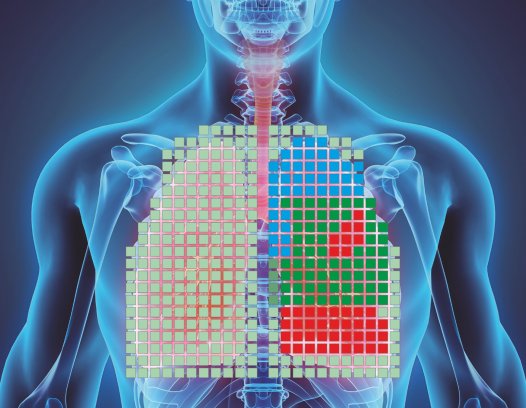
Microfibres may stop lungs mending in COVID patients
Patients with severe respiratory or lung diseases require intensive treatment and their lung function needs to be monitored on a continuous basis.

24th August 2022
Innovation in Textiles
|
Berlin
As part of the Pneumo.Vest project, German researchers at the Fraunhofer Institute for Ceramic Technologies and Systems (IKTS) in Berlin have developed a technology enabling noises in the lungs to be recorded using a textile vest with integrated acoustic sensors – as an alternative to the stethescope which doctors have relied on for over 200 years.
The signals are converted and displayed visually using software so that patients outside of intensive care units can still be monitored continuously.
Piezoceramic acoustic sensors have been incorporated into the front and back of the vest to register any noise produced by the lungs in the thorax, no matter how small. A software programme records the signals and electronically amplifies them, while the lungs are depicted visually on a display. As the software knows the position of each individual sensor, it can attribute the data to its precise location. This produces a detailed acoustic and optical picture of the ventilation situation of all parts of the lungs.
Cricially, because the system collects and stores the data permanently, examinations can take place at any given time and in the absence of hospital staff. Pneumo.Vest also indicates the status of the lungs over a period of time, for example over the previous 24 hours.
“Pneumo.Vest is not looking to make the stethoscope redundant and does not replace the skills of experienced pneumologists,” explains Ralf Schallert, project manager at Fraunhofer IKTS. “However, auscultation – the action of listening to sounds from the heart, lungs, or other organs, typically with a stethoscope, as a part of medical diagnosis – or even CT scans of the lungs only ever present a snapshot at the time of the examination. Our technology provides added value because it allows for the lungs to be monitored continuously in the same way as a long-term ECG, even if the patient is not attached to machines in the ICU but has instead been admitted to the general ward,”
Machine learning algorithms
Alongside the acoustic sensors, the software is at the core of the vest and is responsible for storing, depicting and analyzing the data. It can be used by the doctor to view the acoustic events in specific individual areas of the lungs on the display. The use of algorithms in digital signal processing enables a targeted evaluation of acoustic signals. This means it is possible, for example, to filter out heartbeats or to amplify characteristic frequency ranges, making lung sounds, such as rustling or wheezing, much easier to hear.
On top of this, the researchers at Fraunhofer IKTS are developing machine learning algorithms. In the future, these will be able to structure and classify complex ambient noises in the thorax before the pneumologist carries out a final assessment and diagnosis.
Patients can also benefit from the digital sensor alternative. When wearing the vest, they can recover without requiring constant observation from medical staff. They can transfer to the general ward and possibly even be sent home and move about more or less freely. Despite this, the lungs are monitored continuously, and any sudden deterioration can be reported to medical personnel straight away.
The first tests with staff at the University Clinic for Anesthesiology and Intensive Therapy at the University of Magdeburg have shown that the concept is successful in practice.
“The feedback from doctors was overwhelmingly positive. The combination of acoustic sensors, visualization and machine learning algorithms will be able to reliably distinguish a range of different lung sounds,” says Schallert.
The technology was initially designed for respiratory patients, but it also works well for people in care facilities and for use in sleep laboratories. It can also be used to train young doctors in auscultation.

Business intelligence for the fibre, textiles and apparel industries: technologies, innovations, markets, investments, trade policy, sourcing, strategy...
Find out more